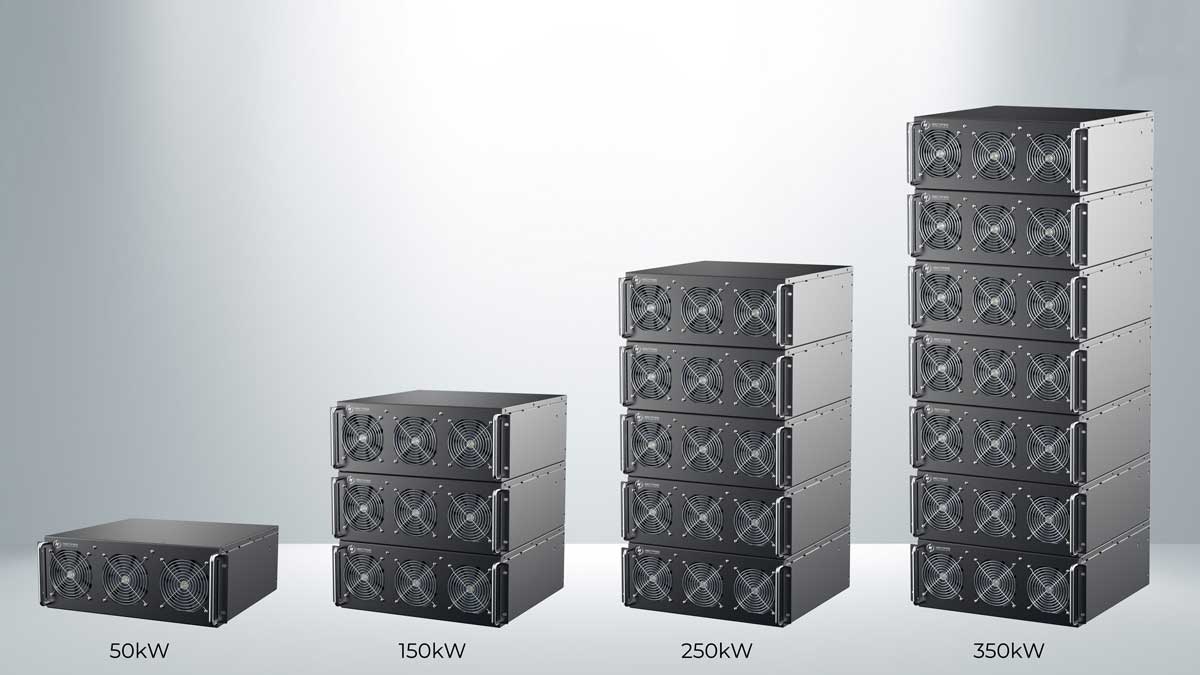1. Overview of the development of charging module industry
Charging modules are the core of DC charging piles for new energy vehicles. As the penetration rate and ownership of new energy vehicles in China continue to increase, the demand for charging piles is increasing. New energy vehicle charging is divided into AC slow charging and DC fast charging. DC fast charging has the characteristics of high voltage, high power and fast charging. As the market pursues charging efficiency, the market scale of DC fast charging piles and charging modules continues to expand. .
2. Technical level and characteristics of the ev charging module industry
The new energy vehicle charging pile ev charger module industry currently has technical features such as single module high power, high frequency, miniaturization, high conversion efficiency, and wide voltage range.
In terms of single module power, the new energy charging pile charging module industry has experienced the mainstream product development of 7.5kW in 2014, constant current 20A and 15kW in 2015, and constant power 25A and 15kW in 2016. The current mainstream application charging modules are 20kW and 30kW. Single-module solutions and conversion to 40kW new energy charging pile power supply single-module solutions. High-power charging modules have become a market development trend in the future.
In terms of output voltage, the State Grid issued the 2017 version of the “Qualification and Ability Verification Standards for Electric Vehicle Charging Equipment Suppliers” stating that the output voltage range of DC chargers is 200-750V, and the constant power voltage covers at least the 400-500V and 600-750V ranges. Therefore, all module manufacturers generally design modules for 200-750V and meet constant power requirements. With the increase in the cruising range of electric vehicles and the demand of new energy vehicle users to reduce charging time, the industry has proposed an 800V super fast charging architecture, and some companies have realized the supply of DC charging pile charging modules with a wide output voltage range of 200-1000V. .
In terms of high-frequency and miniaturization of charging modules, the power of single-machine modules of new energy charging pile power supplies has increased, but its volume cannot be expanded proportionally. Therefore, increasing the switching frequency and integrating magnetic components have become important means to increase power density.
In terms of charging module efficiency, major companies in the new energy charging pile charging module industry generally have a maximum peak efficiency of 95%-96%. In the future, with the development of electronic components such as third-generation power devices and the popularization of electric vehicles with 800V or even higher With a high voltage platform, the industry is expected to usher in products with peak efficiency of more than 98%.
As the power density of charging modules increases, it also brings greater heat dissipation problems. In terms of heat dissipation of charging modules, the current mainstream heat dissipation method in the industry is forced air cooling, and there are also methods such as closed cold air ducts and water cooling. Air cooling has the advantages of low cost and simple structure. However, as the heat dissipation pressure further increases, the disadvantages of air cooling’s limited heat dissipation capacity and high noise will further become apparent. Equipping the charging module and gun line with liquid cooling has become a major solution. technical direction.
3. Technological progress accelerates the development opportunities of new energy industry penetration
In recent years, new energy industry technology has continued to make progress and breakthroughs, and the increase in penetration rate has promoted the continuous development of the upstream charging module industry. The significant increase in battery energy density has solved the problem of insufficient cruising range of new energy vehicles, and the application of high-power charging modules has greatly shortened charging time, thus accelerating the penetration of new energy vehicles and the construction of supporting charging piles. In the future, the integration and deepening application of technologies such as optical storage and charging integration and V2G vehicle network integration are expected to further accelerate the penetration of new energy industries and the popularization of consumption.
4. Industry competition landscape: The charging module industry is fully competitive and the product market space is large.
The charging module is the core component of DC charging piles. With the increase in the penetration rate of new energy vehicles around the world, consumers are increasingly anxious about charging range and charging convenience. The market demand for DC fast charging charging piles has exploded, and the domestic charging pile operation market has grown from In the early days, the State Grid was the main force in diversified development. A number of social capital operators with both charging pile equipment manufacturing and operating capabilities emerged rapidly. Domestic charging module manufacturers continued to expand their production and sales scale for the construction of supporting charging piles, and their comprehensive competitiveness continued to strengthen. .
At present, after years of product iteration and development of charging modules, industry competition is sufficient. Mainstream products are developing in the direction of high voltage and high power density, and the product market space is large. Enterprises in the industry mainly obtain higher market share and profit levels by continuously improving product topology, control algorithms, optimizing hardware and production systems, etc.
5. Development trends of ev charging modules
As charging modules usher in huge market demand, technology continues to develop toward high power density, wide voltage range, and high conversion efficiency.
1) Policy-driven shift to demand-driven
In order to support and promote the development of new energy vehicles, the construction of charging piles was mainly led by the government in the early stage, and gradually guided the development of the industry towards an endogenous driving model through policy support. Since 2021, the rapid development of new energy vehicles has placed huge demands on the construction of supporting facilities and charging piles. The charging pile industry is completing the transformation from policy-driven to demand-driven.
Faced with the increasing number of new energy vehicles, in addition to increasing the density of charging pile layout, charging time must be further shortened. DC charging piles have faster charging speeds and shorter charging times, which are more suitable for the temporary and emergency charging needs of electric vehicle users, and can effectively solve the problems of electric vehicle range anxiety and charging anxiety. Therefore, in recent years, the market scale of DC fast charging in newly built charging piles, especially public charging piles, has grown rapidly and has become a mainstream trend in many core cities in China.
To sum up, on the one hand, as the number of new energy vehicles continues to grow, the supporting construction of charging piles needs to be continuously improved. On the other hand, electric vehicle users generally pursue DC fast charging. DC charging piles have become the mainstream trend, and charging modules have also entered the demand. A stage of development in which pull is the main driving force.
(2) High power density, wide voltage range, high conversion efficiency
The so-called fast charging means high charging power. Therefore, under the growing demand for fast charging, charging modules continue to develop in the direction of high power. The high power of the charging pile is achieved in two ways. One is to connect multiple charging modules in parallel to achieve power superposition; the other is to increase the single power of the charging module. Based on the technical needs of increasing power density, reducing space, and reducing the complexity of electrical architecture, increasing the power of a single charging module is a long-term development trend. my country’s charging modules have gone through three generations of development, from the first generation 7.5kW to the second generation 15/20kW, and are now in the conversion period from the second generation to the third generation 30/40kW. High-power charging modules have become the mainstream of the market. At the same time, based on the design principle of miniaturization, the power density of charging modules has also increased simultaneously with the increase in power level.
There are two paths to achieve higher power level DC fast charging: increasing the voltage and increasing the current. The high-current charging solution was first adopted by Tesla. The advantage is that the cost of component optimization is lower, but high current will bring higher heat loss and high requirements for heat dissipation, and thicker wires reduce convenience and promote To a lesser extent. The high-voltage solution is to increase the maximum operating voltage of the charging module. It is currently a commonly used model by car manufacturers. It can take into account the advantages of reducing energy consumption, improving battery life, reducing weight, and saving space. The high-voltage solution requires electric vehicles to be equipped with a high-voltage platform to support fast charging applications. Currently, the fast charging solution commonly used by car companies is the 400V high-voltage platform. With the research and application of the 800V voltage platform, the voltage level of the charging module will be further improved.
The improvement of conversion efficiency is a technical indicator that charging modules always pursue. The improvement of conversion efficiency means higher charging efficiency and lower losses. At present, the maximum peak efficiency of charging modules is generally 95%~96%. In the future, with the development of electronic components such as third-generation power devices and the output voltage of charging modules moving towards 800V or even 1000V, the conversion efficiency will be further improved.
(3) The value of ev charging modules increases
The charging module is the core component of the DC charging pile, accounting for about 50% of the hardware cost of the charging pile. The improvement of charging efficiency in the future mainly depends on the performance improvement of charging modules. On the one hand, more charging modules connected in parallel will directly increase the value of the charging module; on the other hand, the improvement of the power level and power density of the single charging module depends on the optimized design of hardware circuits and control software as well as the technology of key components. Breakthroughs, these are key technologies for improving the power of the entire charging pile, which will further increase the value of the charging module.
6. Technical barriers in the ev power charging module industry
Power supply technology is an interdisciplinary subject that integrates circuit topology technology, digital technology, magnetic technology, component technology, semiconductor technology, and thermal design technology. It is a technology-intensive industry. As the heart of the DC charging pile, the charging module directly determines the charging efficiency, operational stability, safety and reliability of the charging pile, and its importance and value are outstanding. A product requires a large investment of resources and professionals from technology research and development to terminal application. How to select electronic components and layout, software algorithm upgrade and iteration, accurate grasp of application scenarios, and mature quality control and testing platform capabilities will all affect Product quality and stability have a direct impact. It is difficult for new entrants to the industry to accumulate various technologies, personnel, and application scenario data in a short period of time, and they have high technical barriers.
Post time: Oct-31-2023

 Portable EV Charger
Portable EV Charger Home EV Wallbox
Home EV Wallbox DC Charger Station
DC Charger Station EV Charging Module
EV Charging Module NACS&CCS1&CCS2
NACS&CCS1&CCS2 EV Accessories
EV Accessories

